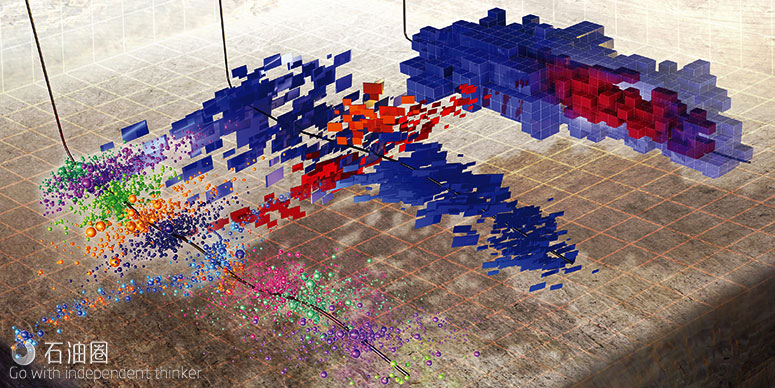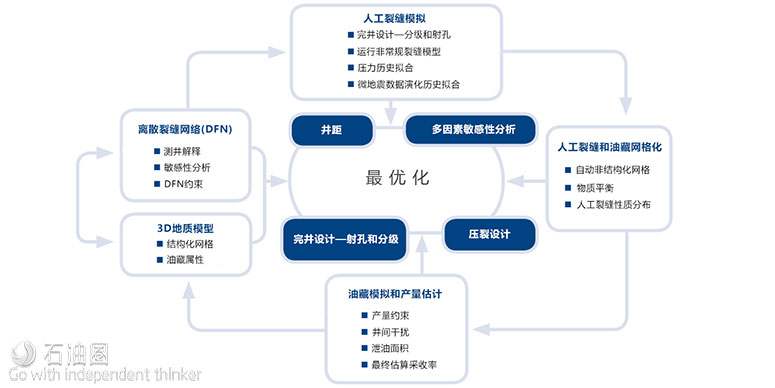Reservoir-centric stimulation-to-production software in the Petrel platform
Kinetix Shale reservoir-centric stimulation-to-production software is the only hydraulic fracturing design software that employs a seamless, comprehensive seismic-to-simulation workflow for the multilevel optimization of unconventional reserves. This member of the Kinetix simulation software suite integrates geophysics, geology, petrophysics, completion engineering, reservoir engineering, and geomechanics in a repeatable workflow that ensures data integrity and high decision quality. With these multiple capabilities, users of this Petrel E&P platform plug-in can maximize production performance and ROI in any reservoir, from conventional to unconventional tight sands and shale.
Multiple models with explicit reservoir gridding for hydraulic fracture simulation
Kinetix Shale software accesses multiple models for the best fit between the science and the reservoir.
Unconventional fracture model—The UFM unconventional fracture model is a fully coupled numerical modeling solution for simulating complex fracture geometries while accounting for reservoir heterogeneity, stress anisotropy, and 3D stress-shadow effects. It efficiently models hydraulic fracture interactions with multilayer natural fractures as it solves for fracture propagation mechanics and proppant transport.
Wiremesh model—The wiremesh model mathematically represents the hydraulic fracture network to provide a quick estimate of proppant placement and fracture network dimensions.
Full 3D design simulator model—Powered by high-performance engines, the Planar3D fracture simulation engine is a full 3D model with stress-shadow capability that creates the most accurate planar fracture simulations for formations with complex stress profiles.
High-resolution simulation grids are automatically generated by explicitly gridding complex fracture networks while capturing the fracture dimensions and conductivities and also tracking the propped and unpropped regions in the networks. The high resolution is paired with new computational efficiency: Resources permitting, multiple simulations can be spawned for the UFM and Planar3D models in batch mode, on a local machine or in the cloud.
Applications
1.Stimulation of conventional, unconventional, and tight sand reservoirs;
2.Vertical, deviated, and horizontal wells;
3.Multistage completion design;
4.Production optimization at the well, pad, and asset level.
Benefits
Seamless integration of geophysics, geology, petrophysics, completion engineering, reservoir engineering, and geomechanics in a repeatable workflow ensures data integrity and decision quality
Inclusion of petrophysical analysis enables evolution from geometrically spaced perforations to strategic staging and perforation selection
High-fidelity simulators account for geomechanical effects during fracturing and production to provide significant new insight for decision making at the well, pad, or asset level, for new developments, infill, or refracturing operations
Automated parallel assessment of up to hundreds of design scenarios in the cloud brings new efficiency to stimulation optimization
Features
1.Integrated, repeatable workflow;
2.Multistage completion design;
3.Capture of 3D geological and geomechanical characterization;
4.Fit-for-purpose high-fidelity numerical models for planar and nonplanar fractures;
5.Multilevel stress shadow (from within stage to between wells) in 2D and 3D for modeling sequential fracturing execution;
6.High-resolution fracture hydrodynamics and in situ kinetics model;
7.Multilayer discrete fracture network (DFN);
8.3D finite-element geomechanical simulation;
9.Structured and unstructured gridding;
10.High-resolution reservoir simulation for production forecasting and calibration;
11.Sensitivity framework powered by cloud computing;
12.State-of-the-art visualization;
13.Explore Kinetix.
Kinetix Shale Stimulation-to-Production Software Increases Production by 40% in Eagle Ford Shale
Limited hydraulic fracture growth and productivity in unconventional wells
An operator with wells in an oil-rich sector of the Eagle Ford Shale experienced variability in production results, which is typical in unconventional plays. The natural fracture pattern and density in the rock fabric limited hydraulic fracture growth and well productivity.
Slickwater and hybrid hydraulic fracturing techniques have been historically used on these wells to stimulate hydrocarbon production, but these techniques were unsuccessful in this environment. To improve productivity and reduce costs in this challenging reservoir, the operator sought to apply an integrated reservoir characterization and well completion study to develop an engineered approach.
Integrated reservoir characterization and multiwell completion workflow design
Two pads with three and five horizontal wells, respectively, were chosen to be studied in the area of interest in the Eagle Ford Shale. The Kinetix Shale software’s workflow was used to evaluate and develop the optimal completion strategies for the candidate wells—all in the Petrel* E&P software platform. A 3D geological model with seismic data; structural definition; reservoir, petrophysical, and geomechanical properties; image logs; and fracturing history with microseismic data served as inputs for creating a robust model for the integrated study.
The stimulation designs were created using a state-of-the-art UFM* unconventional fracture model in the Kinetix Shale software. The microseismic data collected during hydraulic fracturing treatments was used to further calibrate the fracture geometry and footprint.
An important final step in the workflow was to couple the complex hydraulic fracture design to production simulation in the Kinetix Shale software. Automated unstructured gridding was used to capture the granularity of the complex hydraulic fractures from all the wells. This provided a rigorous model to predict the production response from the tridimensional fracture network. Well-to-well interference and overall reservoir depletion from the induced hydraulic fractures could then be precisely simulated.
After the model was calibrated and matched to the observed production behavior, optimized completion strategies were designed based on the multiwell pad completion scenario. Parametric studies were run on different completions, fracture treatment variables, and well spacing scenarios.
Optimized design and well spacing
After applying the optimized treatment designs on a dozen wells in the field, the operator increased production by 40% and reduced completion costs by 11% on an average. The robust workflow in the Kinetix Shale software also provided a building block for future optimization of hydraulic fracture design treatments.
Reservoir Model Helps Plans for Infill Wells to Avoid Productivity Losses, Eagle Ford Shale
Fracture hits significantly reduce production in parent well
In recent years, many operators have encountered well interference when fracturing laterals adjacent to existing productive parent wells at drill-to-hold lease sites. Reduced pressure from previously stimulated or depleted areas creates a path of least resistance for a nearby infill well stimulation, causing mild, severe, or complete production impairment of the parent well.
Schlumberger investigated interwell interference on Eagle Ford parent wells and infill wells and its impact on production.
Integrate multiple data sources to accurately model and minimize risk
Schlumberger stimulation, reservoir, and geomechanics engineers developed an integrated workflow beginning with a geocellular model constructed using 3D seismic data, stratigraphic correlations from offset vertical pilot wells, and openhole well log data. The 3D seismic data were also used to characterize the spatial variability of natural fracture intensity and orientation to build the DFN model. A UFM* unconventional fracture model was generated in the Kinetix Shale* reservoir-centric stimulation-to-production software to simulate the hydraulic fracture network created with each pumping schedule in the Eagle Ford Shale.
Initial production and depletion of the parent well were simulated with the INTERSECT? high-resolution reservoir simulator, which included pressure-volume-temperature data, relative permeability, and pressure-dependent fracture conductivity.
The simulated 3D reservoir pressure field was imported into the VISAGE* finite-element geomechanics simulator to determine the spatial and temporal evolution of magnitude and azimuth of the in situ stresses, which were then used as input to model fracture propagation for the infill well. A final simulation combining the parent and infill well completed the workflow.
Operators optimize development strategies to minimize risks
The ability to model pressure depletion and the associated new stress state with respect to the time between production of the parent well and fracturing of the infill well was an integral part of the overall basin production strategy. The complex interaction between stress reduction, stress anisotropy, and stress reorientation with the DFN determined if newly created fractures will propagate toward or deflect away from the parent well.
In recognition that the UFM model workflow enables a deeper understanding of how to rationalize complex drilling and completion operations, several Eagle Ford Shale operators have selected Schlumberger to model the complex fractures and interwell interference. The Kinetix Shale software’s stimulation design and modeling workflow has been used for subsequent development strategies, including optimization of infilling and refracturing programs, spacing of infill well laterals, and control of fracture propagation to minimize undesired fracture hits and other interferences.

 石油圈
石油圈

